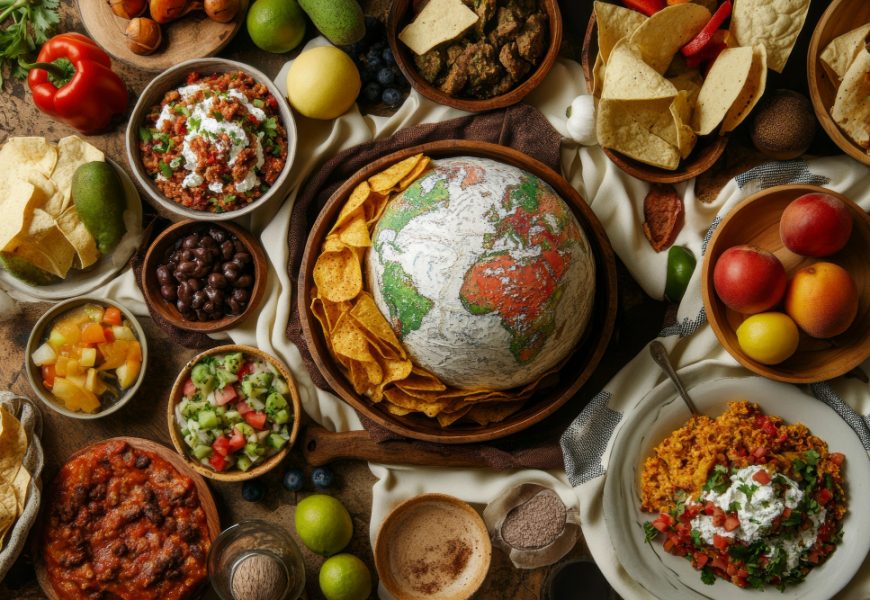The Shared Human Journey of Nourishment
From the first sparks of fire in ancient caves to the state-of-the-art kitchens of global cities today, food has never simply been about staying alive. Across continents, generations, and cultures, it has served as a vessel of identity, memory, and connection. When we look closely, we see that while the crops pulled from the soil or the spices gathered from distant coasts may differ, the underlying intention is profoundly alike: to nourish, to comfort, to create, and to commune.
Consider the hunter-gatherers who learned to roast wild grains and seeds, not only to make them digestible but to find satisfaction in warmth and flavor. Thousands of years later, families gather at dinner tables in sprawling metropolises—London, Lagos, Mumbai, Buenos Aires—performing essentially the same act. From fire pits to gas stoves, from foraged roots to refined sauces, the continuity is clear: food binds us.
This unbroken heritage reflects not only practical survival but also the need to mark who we are, where we belong, and how we understand others. Borders, oceans, and distance have divided geography, yet food has consistently crossed them—through trade, migration, or sheer curiosity—turning once-local flavors into global traditions. The story of humanity is written with salt, spice, and sustenance, and it is a story that has always been shared.
The Emotional Language of Meals
Food, in every society, is more than nutrition—it is a form of communication that transcends words. Cultures across the world use meals to speak the language of love, grief, joy, or unity. The patient stews that simmer for hours in African kitchens offer care and warmth, while the neatly folded dumplings of East Asia represent skill, togetherness, and often, prosperity. South Asian curries—ripe with layers of spice—embody the celebration of complexity and abundance, and European loaves of bread, slowly risen and kneaded, reflect community, patience, and trust.
Rituals surrounding food map onto every moment of the human life cycle. Births are greeted with sweets or festive dishes, weddings with banquets, funerals with shared meals that ease sorrow. Even ordinary gatherings—friends over coffee in Istanbul, families at Sunday lunch in France, farmers sharing maize under the open skies of Mexico—carry layers of symbolism.
The act of preparing and offering food becomes storytelling without narration. A Peruvian farmer and a Greek shepherd may not share language, but each understands what it means when a guest is given their best portion. In this way, food is an emotional code book shared across humanity, a silent recognition that we all find belonging and expression at the table.
The Balance Between Necessity and Creativity
Though the starting point of any dish is necessity—the need to fill an empty stomach—the outcome is rarely so simple. Across continents, people have elevated their most available resources into something imaginative, even sublime. This is where food transcends survival and becomes culture.
Grains, for example, show this balance beautifully. Rice in Asia becomes everything from steamed comfort food to intricate sushi rolls. Maize in the Americas forms the core of tortillas, tamales, and countless variations. Wheat—whether baked into flatbreads across the Middle East or crusty loaves in Europe—serves as daily sustenance yet always carries local identity. Millet, common in parts of Africa and India, is transformed into porridges, breads, or beverages uniquely tied to regional customs.
Techniques also reflect global ingenuity: fermentation in Korea that turns cabbage into kimchi, grilling in Argentina that elevates beef into a national symbol, spice blending in India that turns humble legumes into aromatic feasts, or communal stewing in West Africa that makes one pot stretch to feed many. Each is a reminder that with imagination, the ordinary becomes extraordinary.
This marriage of necessity and creativity unites kitchens worldwide: the impulse to take what is at hand and make it not just edible, but meaningful. Food thus fulfills two simultaneous needs: it sustains the body, and it nourishes culture.
The Table as a Global Gathering Place
Beyond ingredients and techniques, one of the strongest shared elements of culinary traditions is the table—or its cultural equivalent. Wherever you are in the world, food gains its fullest power when eaten together. It is the act of sharing that transforms eating into a ritual of belonging.
In Japan, the tea ceremony is less about the beverage itself and more about respect, mindfulness, and presence. In the Middle East, the pouring of coffee to a guest is as much an act of hospitality as it is refreshment. In Ethiopia, eating from a shared platter represents solidarity and trust, while in Italy, long family-style meals weave together generations in conversation.
These practices, diverse on the surface, share a universal principle: food builds relationships. It mends fences, marks agreements, and solidifies community. Migration and globalization have added new flavors to every region, but the act of coming together around a table remains unchanged. Meals are our most accessible form of diplomacy, wordless yet deeply powerful statements of inclusion.
What unites culinary traditions across continents is not just a list of shared ingredients or similar cooking methods. It is the deep human impulses reflected in every pot, plate, and gathering: to transform necessity into creativity, to embed emotions into rituals of flavor, and to use the table as a gathering place strong enough to transcend languages and borders.
Food is our universal story. It is as old as the first fire and as fresh as tonight’s dinner. It reconciles survival with meaning, individuality with community, the local with the global. Whether through a steaming bowl of noodles, a piece of flatbread passed around, or coffee shared with strangers, we find that the act of eating unites us far more strongly than it divides us.
The human journey may be scattered across continents, but in every land, among every people, food has always been both sustenance and symbol—the most elemental, enduring bridge between us all.








